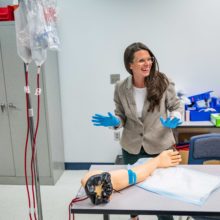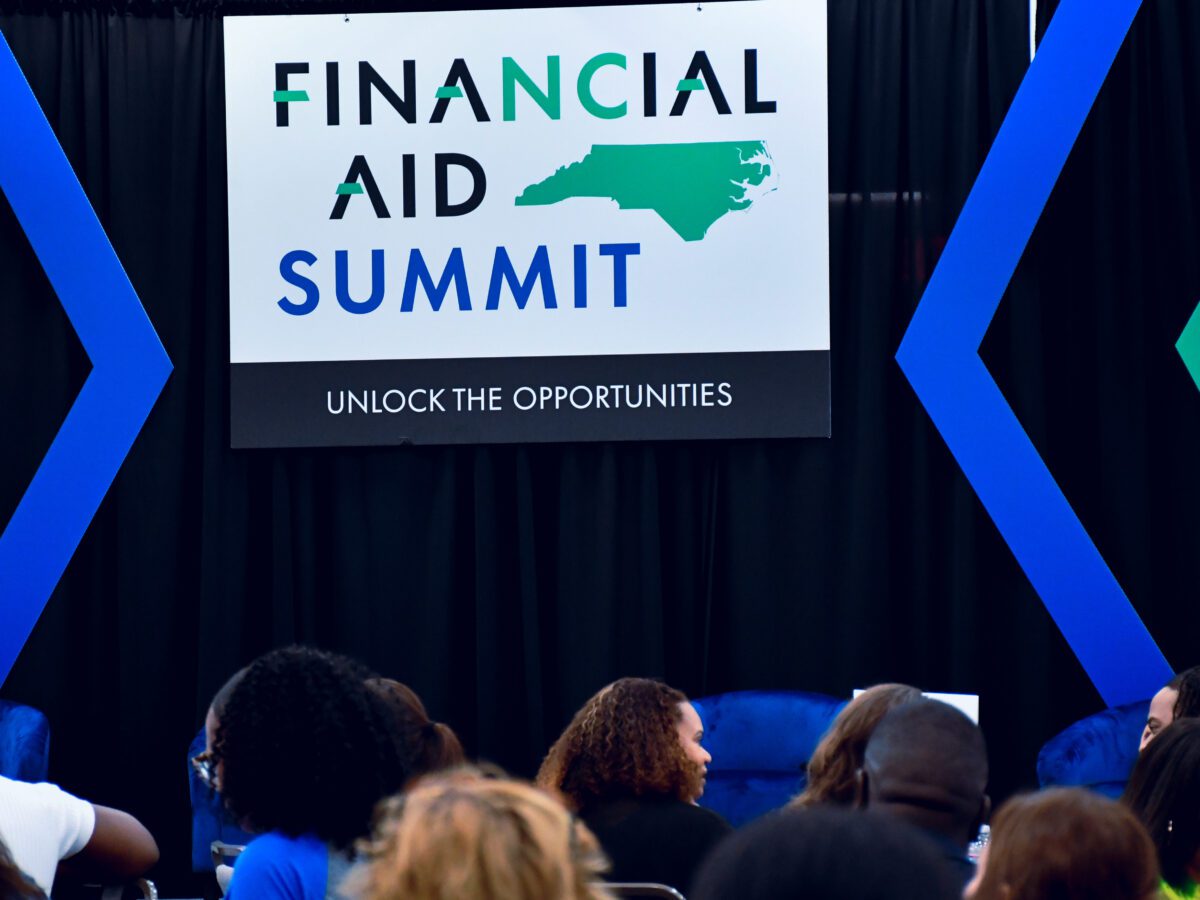
Share this story
- North Carolina education partners recently hosted the first-ever Financial Aid Summit to discuss FAFSA changes, strategies for increasing FAFSA completion, and more.
- FAFSA is changing, and North Carolina’s grant scholarship program is getting a makeover - here’s what you need to know about the revamp.
|
|
Finances are personal. It’s not always an easy subject to talk about, but finances and paying for college are at the forefront for many families.
At this year’s first-ever Financial Aid Summit in North Carolina, school district financial aid leaders and partner organizations from across the state convened to discuss strategies around increasing postsecondary attainment and students completing the Free Application for Federal Student Aid (FAFSA). Event organizers also shared upcoming changes to the FAFSA and a new consolidated scholarship for the state.
When it comes to pursuing a postsecondary credential, cost continues to be one of the biggest barriers to success for students, said Cecilia Holden, president and CEO of myFutureNC.
It’s not just cost though. Often the very process of finding and securing funds to pay for college is a hurdle.
A first step to accessing financial aid at the federal, state, and college level is completing the FAFSA. The FAFSA unlocks a variety of aid at the federal level including Federal Pell Grants, work-study programs, scholarships, and loans. In North Carolina, most colleges and universities use the application to divide and disburse state aid and scholarships.
But the application process can be confusing.
In most cases, dependent students need to provide their legal parents income and tax information. This can be challenging for students who don’t live with their legal parents or have circumstances preventing them from accessing this information.
Other challenges to FAFSA completion include language barriers, reliable internet, a misunderstanding about why completing the FAFSA is important, and more.
MC Belk Pilon, president and board chair of the John M. Belk Endowment (JMBE) and one of the summit sponsors, said the core of the event is to mount the most effective possible efforts to increase FAFSA completion. And beyond FAFSA completion – it’s increasing and unlocking opportunities for students when it comes to credential attainment and paying for college.
As summit speakers noted, part of unlocking those opportunities lies in a collaborative effort that includes sharing ideas, resources, and best practices.
When it comes to FAFSA completion, how does N.C. compare?
In 2022, high school seniors across the nation left $3.58 billion on the table in Pell Grants. A Pell Grant is money from the government given to students whose Expected Family Contribution (EFC) falls below a certain amount. Unlike loans, grants do not have to be repaid.
According to Bill DeBaun, senior director of data and strategic initiatives at the National College Attainment Network (NCAN), FAFSA completion is a good leading indicator of whether or not students are going to enroll in college.
What else can FAFSA completion rates tell us?
For starters, FAFSA completion is inequitably distributed. Higher levels of poverty in a school district correlate to lower FAFSA completion rates – which means those that most need the aid are not accessing it.
At the national level, DeBaun said FAFSA completion is holding at a 4% growth rate year over year. A little over half of high school seniors across the country have completed the application.
North Carolina is outpacing the country with about a 6% growth rate year over year. However, only 48.6% of high school seniors in the state have completed the FAFSA for the 2023-24 award year so far.
Experts are hopeful the upcoming changes to the FAFSA will help with overall completion rates.
How is FAFSA changing?
The FAFSA Simplification Act, passed in 2020, changes the processes and systems currently in place to award federal student aid. DeBaun said this is the first major redesign of FAFSA in more than 40 years.
Most of these changes will take effect starting with the 2024-25 award year. States who use the FAFSA to award state grant aid will also be impacted.
Here are some of the changes ahead:
Delayed FAFSA opening
In recent years, students were eligible to fill out the FAFSA beginning Oct. 1. Amid changes to the form, policies, and procedures, the FAFSA is set to open sometime in December 2023 for the 2024-25 award year. An exact date should be announced sometime this summer.
Expected Family Contribution (EFC) now called Student Aid Index (SAI)
EFC will now be called SAI. The rename more closely aligns with the formula’s intention – an index number that’s used to determine financial need.
Families were often confused by the term EFC because they assumed the number implied the amount they would need to pay for their student(s) to attend college. Rebranding using SAI language will hopefully clarify that the number is an index used to assess financial need.
Increasing Pell eligibility and awards
The overhaul is expected to increase the number of students who receive Federal Pell Grants.
SAI will be calculated differently than EFC has been in the past. One of the major changes includes the number of family members in college.
In previous years, the EFC formula factored in how many other family members were enrolled in college to determine need, but the new SAI formula will no longer do this. This is an area financial aid leaders recognize could mean less financial aid for those who have multiple family members in college and have an adjusted gross income above a certain amount.
But not always.
While the new SAI formula will no longer use the number of family members in college, it does link family size and the federal poverty level to determine eligibility and need.
According to this FAFSA guide, the SAI formula allows a minimum SAI of -$1,500 and uses a separate eligibility criteria for Federal Pell Grants. This is a big change from EFC. Before, the lowest EFC you could generate was $0. You can view examples of the SAI calculations here.
Also changing is eligibility for those in the justice system. Starting in July 2023, individuals incarcerated in a federal or state prison and enrolled in an approved education program will be eligible to receive Pell Grants.
A streamlined form
For decades, those completing the FAFSA were met with over a hundred questions. That’s all changing. Completers will now answer somewhere between 30 to 40 questions. Experts say the questions are intended to be much simpler and easier to understand.
Applicants will also be able to import tax information directly from the IRS.
Other changes:
- Students with separated or divorced parents will need the parent who provided the most financial support in the previous calendar year to complete the FAFSA.
- In the past, small businesses or family farms with fewer than 100 employees were not required to be reported as part of net worth when completing the FAFSA. The 2024-25 FAFSA will now require this as part of the calculation to determine eligibility and need.
The new consolidated scholarship for North Carolina
State aid for students attending one of North Carolina’s community colleges or UNC institutions is changing.
The public sector programs – UNC Need-Based Grant, the Education Lottery Scholarship, and the Community College Grant – will now be consolidated into one scholarship program.
One of the goals for combining the three programs is to help students understand the aid that is available to them, said Andrea Poole, executive director of the North Carolina State Education Assistance Authority (NCSEAA).
The scholarship program simplification comes from recommendations after a 2018 study was conducted to assess the design and delivery of North Carolina’s grant program. You can read more about the study and recommendations here.
The consolidated scholarship will be available to eligible students who enroll in college starting fall 2023.
How will aid be calculated?
For the 2023-24 award year, EFC and Annual Gross Income (AGI) will be used to determine eligibility and the applicant’s scholarship amount. The SAI formula will take effect the following award year.
In this Perspective for EdNC, Poole writes:
North Carolina students whose EFC is below $7,500 and whose family’s AGI is less than $75,000 are guaranteed at least $2,800 in combined state and federal aid for community college tuition and fees and at least $5,000 toward tuition and fees at the state’s four-year public universities.
Students must complete the FAFSA on time and qualify for in-state tuition. Click here to read more about scholarship eligibility and deadlines for the 2023-24 academic term.
A community-wide approach
As event organizers reiterated, “We’re all in this together.”
And togetherness is often found and strengthened when you step out and share your story. That’s what several speakers did during the summit.
Between the information about FAFSA changes and research, participants heard real stories from real people about their own encounters with financial aid and financial literacy.
A community college president shared her story of earning a G.E.D., the shame she carried as a result, and a chance encounter in a grocery store check-out line that would lead her to college. That same story included bad financial advice that had her repaying a year of student loans and no degree to show for it.

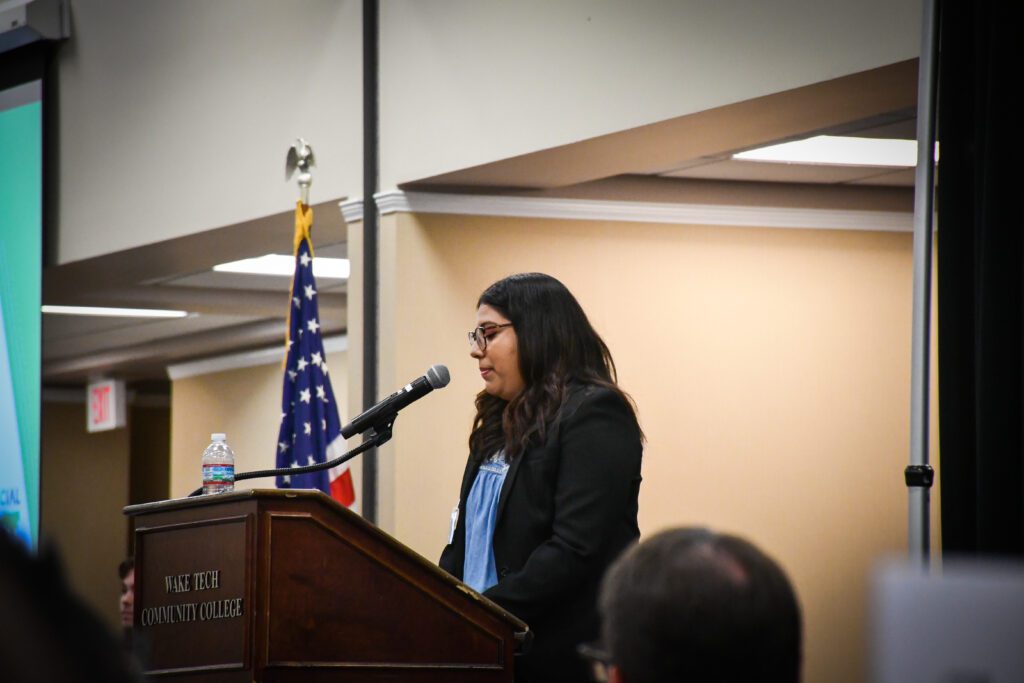
Former student Nayleny Banda told the audience how she sought help from a community member as she navigated financial aid.
“I challenge you all to continue to learn new ways of advocating and creating change for your students and for your community. It only takes one caring adult to make a difference in a student’s life.”
Nayleny Banda
So what did we learn?
It can be a scary and confusing process without someone trustworthy guiding you along the way.
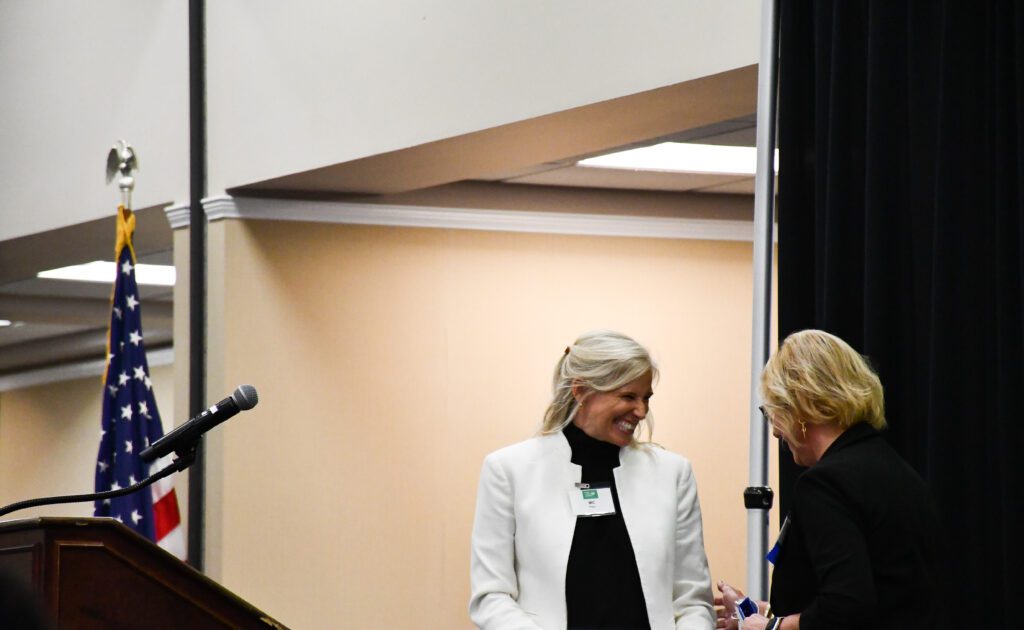
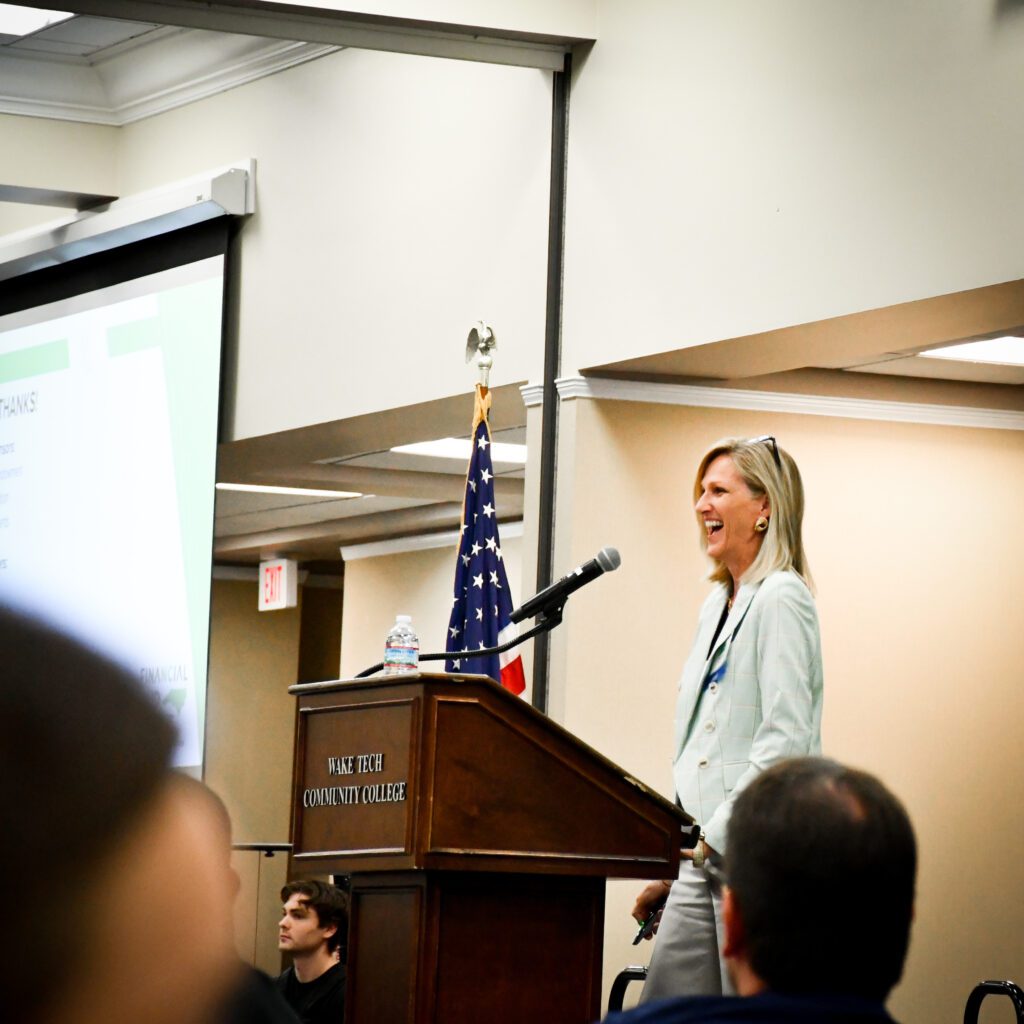
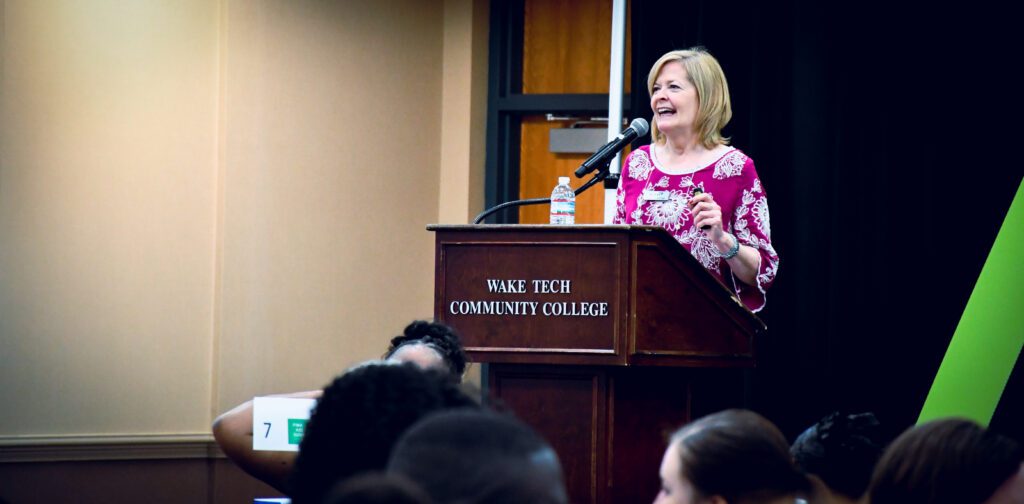
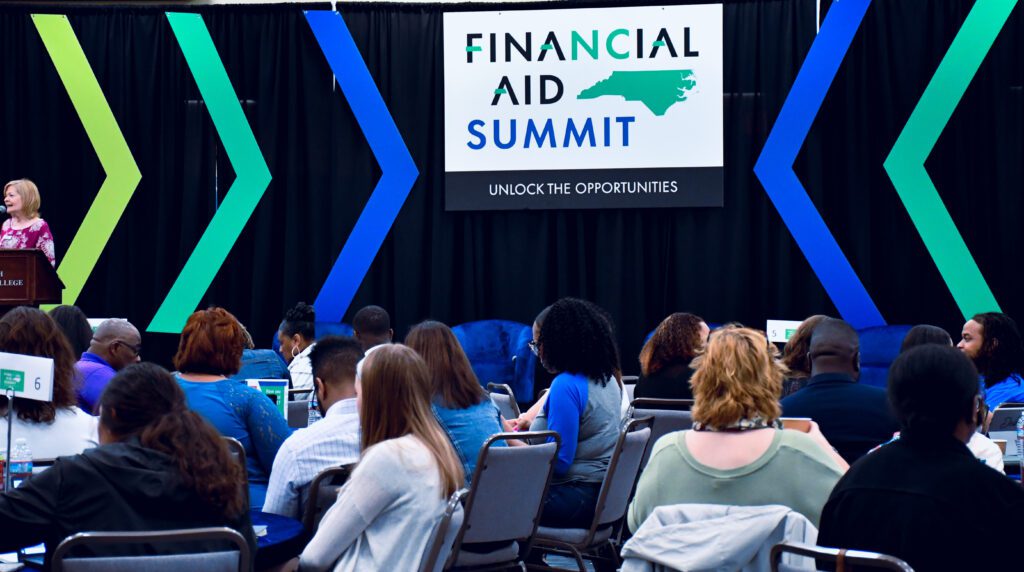
In many ways, that was the goal of the summit – creating a space for school leaders and partner organizations to share ideas and strategize about ways to be guides for students so they can unlock financial aid but also find their path toward postsecondary attainment.
Available resources
EdNC will continue to follow the changes coming down the pike for financial aid.
In the meantime, here are some additional resources available to parents, students, and school leaders.
- CFNC’s FAFSA guide, including an interactive map to help students find local financial aid assistance.
- Scholarships available in North Carolina, including more about the new consolidated scholarship for the state.
- NC’s 529 plan – “an easy way to crowdfund your education savings.”
- Webinar series from NCSEAA on paying for college.
- LatinxEd provides “targeted, multi-year support to Latinx students and immigrant families striving for higher education and greater opportunity.” One of the group’s initiatives is College y Consejos, which is a free online college advising space for Latinx students.
- The N.C. Community College System Scholarship Guide and the system’s Find Help program.
- North Carolina’s FAFSA tracker, where community stakeholders can “track FAFSA completion progress by school and district each week and deploy extra help where it’s needed most.”
- More information from NCAN about national FAFSA completion.
